Catalogue: Engineering
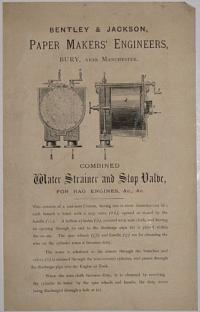
Bentley & Jackson, Paper Makers' Engineers, Bury, Near Manchester. Combined Water Strainer and Stop Valve, for Rag Engines, &c., &c.
[Anon., c.1870s.]
Letterpress broadside, manufacturer's promotional flyer/handbill, with diagram illustration and explanatory text. Sheet 205 x 130mm, 8 x 5".
Advertisement for a specialised part for paper-making machinery. Provenance: from a scrap album compiled c.1840 - 1880 by Alfred Towgood of Riverside, a paper mill owner at St. Neots, Huntingdon. He was also a Lieutenant in the Duke of Manchester's Light Horse.
[Ref: 16459] £70.00
(£84.00 incl.VAT)
![The Parisian Portable Alarum [Alarm],](img-thumbnail/jpegs/16457.jpg)
The Parisian Portable Alarum [Alarm], Sonnerie Tres-Bruyante, Indispensible for Travellers, the Clergy...and all whose professional pursuits require occasionally very early rising. Sold Wholesale and Retail, by William S. Adams, Furnishing Ironmonger, 57, Haymarket, London.
[London, c.1850s.]
Letterpress broadside advertisement label/handbill, for a wind-up mechanical alarm. Sheet 115 x 195mm, 4½ x 7¾".
The application for the "wind up alarm clock" including specific 'Directions for Use' are printed in a way that means this leaflet might have been inserted into the box or packaging with the product. Provenance: from a scrap album compiled c.1840 - 1880 by Alfred Towgood of Riverside, a paper mill owner at St. Neots, Huntingdon. He was also a Lieutenant in the Duke of Manchester's Light Horse.
[Ref: 16457] £95.00
(£114.00 incl.VAT)
![[Trade flyer] Improved Drain Tile Machine. (Etheredge's Patent.)](img-thumbnail/jpegs/18213.jpg)
[Trade flyer] Improved Drain Tile Machine. (Etheredge's Patent.) ...Licenses may be obtained for using the Machine, with terms of Royalty, and every other information, on application to John Cheese, Resident Manager.
For the Proprietors, C. Etheredge & Co. At their Offices, ['16, Park Street, Westminster' crossed in ink, 'No 11 Furnivals Inn London' in ink mss.] [Anon., c.1845.]
Scarce manufacturer's promotional handbill/flyer, illustrated letterpress broadsheet. Sheet 235 x 190mm. 9¼ x 7½". Fold creases as normal.
The text briefly explains the mechanics of the horse-powered machine (illustrated with a diagram) which in one operation turns clay into "tiles or pipes by compression". The verso lists the prizes the machine has received from Agricultural Societies in England, Scotland and Ireland. Frederick William Etheredge obtained his patent in 1842.
[Ref: 18213] £120.00
(£144.00 incl.VAT)
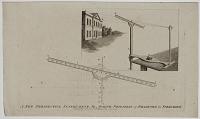
A New Perspective Instrument, By, Joseph Priestley of Bradford in Yorkshire.
Publish'd Dec.r 1.st 1782, by J. Fielding Pater-noster Row.
Engraving. Plate 113 x 172mm (4½ x 6¾").
An illustration of a tool aiding architectural artists present perspective precisely. It was published in Priestley's 'A Familiar Introduction to the Theory and Practice of Perspective'; a discussion of the principles of linear perspective. Joseph Priestley (1733-1804), a theologian, Dissenting clergyman, natural philosopher and a chemist often credited with the discovery of oxygen. Because he found difficulty finding artists capable of illustrating his scientific books, he decided it would be easier to learn how to do it himself; he then published this artist's manual.
[Ref: 28621] £60.00
(£72.00 incl.VAT)
![[Straw-burning ploughing engine.]](img-thumbnail/jpegs/20902.jpg)
[Straw-burning ploughing engine.] [Written on the engine:] Ransomes Sims & Head Ipswich England. Head & Schemioths Patent.
[In ink underneath the image:] Engraved with instruments on waxed plate.
[n.d. c.1848.]
Engraving, scarce. 228 x 342mm. 9 x 13½". Folds and creasing.
Ransomes, Sims & Head, established 1789, was a major British agricultural machinery maker, and also manufactured aeroplanes during the First World War. In 1848, John Head joined the firm as an apprentice and invented an apparatus which enabled straw to be burnt as fuel in the firebox of portable and traction engines. This development, made in collaboration with a Russian engineer named Schemioth, proved a very useful one in countries where there was no wood available for fuel and where coal had to be imported at great expense. The Head-Schemioth system involved the provision of extra-large fireboxes and an apparatus, driven from the crankshaft by a strap, for feeding the straw into the firebox.
[Ref: 20902] £140.00
(£168.00 incl.VAT)
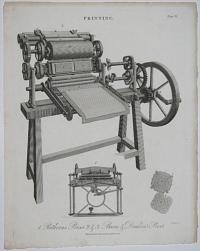
Printing. Plate II. 1. Ruthvens Press. 2.&3. Bacon & Donkin's Press.
J. Pass sc.
Engraved for the Encyclopaedia Londinensis 1826.
Engraving. Plate 160 x 197mm. 6¼ x 7¾".
Two types of printing press. In the early 19th century an Edinburgh printer named Ruthven devised a press in which the type remained stationary, the plate moving over it on a wheeled carriage. One of Bacon and Donkin's revolving cylinder printing machines was later acquired by Cambridge University Press. In the Science & Society Picture Library.
[Ref: 20625] £65.00
(£78.00 incl.VAT)
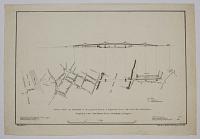
Reduced Plan and Elevation of the proposed Bridge of Suspension from Little Tower Hill to Horslydown. Designed by Capt:n Sam:l Brown: RN and Jam:s Walker Civil Engineer.
F. Barrallier del: Litho: by L: Clark & Co. No.1. Birchin Lane Corn Hill.
[n.d. c.1823.]
Lithograph, rare. Sheet 367 x 538mm. 14½ x 21¼".
A proposed design for a bridge where Tower Bridge now stands. Captain Sir Samuel Brown (1776-1852) was an early pioneer of chain design and manufacture and of suspension bridge design and construction. He is best known for the Union Bridge of 1820, the first vehicular suspension bridge in Britain.
[Ref: 26189] £260.00
(£312.00 incl.VAT)
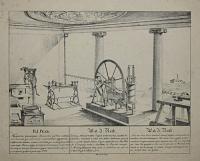
W. & J. Reed. Turning Lathes of modern English Workmanship, suitable for Gentlemen, Amateurs or others who follow Mechanical Pursuits. Also a small Superb Steam Engine applicable to a Saw Mill or for Pumping water, a Saw Frame on Brunel's principle for Cutting veneers, and other pieces of Mechanism on sale at No 229 English Back Line.
Lithog by J.Reed, 1824. No 1.
Lith. chez A.Lange.
Lithograph. Printed area. This very unusual print has the title in Russian, English and French. 265 x 330mm. Spotting in margins
Ex: Collection of The Hon. C. Lennox-Boyd.
[Ref: 4805] £450.00
![[Set of Six.] The descent into the salt-mines of Dürnberg.](img-thumbnail/jpegs/44626.jpg)
[Set of Six.] The descent into the salt-mines of Dürnberg. Entrance to the mine. [&] Sliding-party in the under-part. [&] Passage over the brine-lake in the inner-part of the mountain. [&] Sliding-party in the upper-part. [&] Getting out of the mine (on a wooden horse).
Gez. v. Hanns Brunner.
Eigenthum des Jos. Hinterstoisser am Dürnberge (Vorbehalt jeder Art Nachdruck).
Set of six engravings printed on india paper. Plates: 145 x 125mm (5¾ x 5"), with very large margins. Light foxing.
A series of six plates illustrating various processed of salt-mining in the Durrnberg mines near Salzburg in Austria.
[Ref: 44626] £230.00
(£276.00 incl.VAT)
view all images for this item
![View of the Patent Sa[l]t works & Rock Salt Mine,](img-thumbnail/jpegs/57089.jpg)
View of the Patent Sa[l]t works & Rock Salt Mine,
Print[ed] by C. Hullmandel.
Scarce lithograph, sheet 245 x 460mm (9¾ x 18"). Trimmed losing secondary title. Abrasions losing some letters in text. Laid down on archival paper.
A man with a dog points directions to a man on a horse and a shepherd looks after his flock against the backdrop of smoking chimneys of the Salt Works.
[Ref: 57089] £240.00
(£288.00 incl.VAT)
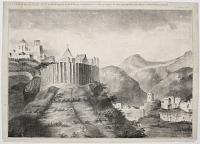
A View of the Rayas Mine, shewing the wall of Stone constructed for the purpose of placing additional whims at the Great Shaft. 31st December 1827
Baynes & Harris Lithog 31 Gracechurch St
Lithograph, sheet 280 x 390mm (11 x 15¼"). Tear lower right; surface loss on right. Very scarce.
San Juan de Rayas mine in the state of Guanajuato, Mexico still in operation.
[Ref: 46944] £360.00
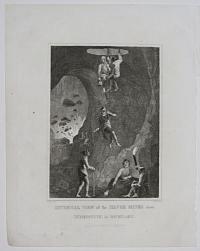
Internal View of the Silver Mines near Schemnitz in Hungary.
Craig del.t. Williams, sc.p.
Bungay Jan.y 7th 1818 Published by Brightly & Childs.
Engraving. 235 x 190mm, 9¼ x 7½".
The interior of a mine, with miners being lowered through a hole in the tunnel roof on ropes. In the background a miner shelters from a blast. Schemnitz is now Banska Stiavnica.
[Ref: 26521] £60.00
(£72.00 incl.VAT)

Commerical Docks. Specification for Lock Gates, Bridges, &c.
December, 1853. Westminster: Vacher & Sons, 29, Parliament Street.
Unique contract and plates, all signed by John Butler and J Pitts. Marble board folio (652 x 430mm), with title slip: "South Dock Contract Drawings. P.L.A. Drawing Officer (1925) DRG. No. 5700428". Plates: 11 extractable large-sized folio sheets (634 x 987mm). Stamped onto the first page of the contract are numerous "Two Shillings Six Pence" stamps with the Royal Emblem of Queen Victoria. Contract 4to (333 x 212mm) in wrapper attached to the inside cover of the folio. Various sections signed by J. Pitts and John Butler, including an illegible signature of a Witness (possibly Italian). Boards scuffed and binding slightly torn. Pages of contract - some holes in places. Some plates missing.
CONTRACT: An agreement made the Twenty Seventh day of March One Thousand eight hundred and fifty four between John Butler and Joseph Pitts of Stanningley near Leeds in the County of York hereinafter called The Contractors of the one part and The Commercial Dock Company of the other part. [The amount to be paid by the Company will be] Twelve thousand three hundred pounds. [The Contract entails that the Contractors] construct and erect and fix four pairs of lock gates. Two pairs - Thames into East Country Dock at Rotherhithe and two pairs in and for the Communication Lock between the said Dock and the Company’s Dock No.1. [Similarly] to construct and erect and fix one barrier bridge across Communication Lock and one foot bridge across the Entrance Lock and eight capstans on the pier heads. [An extra charge or similar] of one thousand and fifteen pounds will be added to make and construct Sluices. The Contractors are responsible for formation and full completion by the deadline, to completely furnish and to make and to execute all additional works required. Gate: to be framed on Company premises at the South side of the New Plough Road. Contractors can unload Messrs. Langton & Sons timber and their barges at the head of dock No.1 - and have use of the Company’s rail with no extra charge but must provide their own labour and machinery. Any extra work must be presented to the Resident Engineer and on Tuesdays a bill must be delivered - or work shall be considered as abandonment, exonerating the Company from liability; all-in-all the Engineers make the final decision. The Contractors have engaged with the Company to have the Works of two lock entrances ready for fixing the gates and bridges within twenty four calendar months from the sixteenth August one thousand eight hundred and fifty two, admitting shipping into the Dock within thirty calendar months - and the Contractors and Contract are to be bound under the terms of this Contract to the same dates of completion. Heights and Depths are of eighteen feet six inches on the Index fixed at the Entrance Lock of No.1 Dock. Contractors are liable for all damage to the works during their execution and for twelve months after their completion. Schedule of Prices. SPECIFICATION. The situation of the Gates of to the Entrance and Communication Locks is shown upon Drawings Nos. 1 & 2; the details of the Gates upon Drawings Nos. 3, 4, 5 & 6. The Machinery for the Gates and Capstans is shown upon Drawing No.7 Gates. Subsections with details: Ironworks, Segment, Rollers and Carriages, Anchors, Caps to Meeting-posts and Heelposts, Pivot-plate, Socket-plates, The-Plates, Screw-eyes, Footpath, Crabs for Opening and Closing the Gates, Capstans, Rollers, Chains, Pointing-sill. Sluices. The numbers and places of the Sluices to the Locks are shown on Drawings Nos. 1 and 2, and the details of the one Sluice on Drawing No.8. Bridge over Communication Lock. The Site of the Lifting Bridge over the Communication Lock is shown upon Drawing No. 2, and the Details upon Nos. 10 and 11. Subsections with details: Machinery, Roadway, Footpaths, Covering-plates, Railing. Foot Bridge across Entrance Lock. The Site of the Foot Bridge over the Entrance Lock is shown upon Drawing No.1, and the Details upon Drawing No.9. Subsection with details: Machinery. Work Generally. Subsections with details: Cast Iron, Wrought Iron, Brass Work, Painting and Tarring.
[Ref: 11312] £1,800.00
view all images for this item
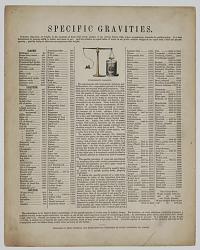
Specific Gravities. Specific Gravity, or weight, is the measure of force with which matter, in its various forms, falles, when unsustained, towards the earth's centre. It is best determined by poising solids in water, and gases in air; and the relation to equal bulks of water or air, is the relative weight of an equal bulk, called the specific gravity; gravity being in this case synonymous with weight. [List of Gases, liquids and solids follows with more text:] ...If a structure of oak weighs 1,170 lbs., a similar one of exactly the same cubic contents, made of deal, would weigh only 555lbs. A bottle capable of containing 10 lbs. of water will hold 18 lbs of sulphuric acid, the latter being nearly twice as heave as the former.
Diagrams of Arts, Sciences, and Manufactures, Published by James Reynolds, 174, Strand. [n.d. c.1860.]
Letterpress and engraving. 285 x 228mm (11¼ x 9").
The hydrostatic balance used for ascertaining the specific gravity of solid bodies, which are suspended in water by a horse-hair attached to the bottom of the scales. From Reynolds' 'Pictorial Atlas of Arts, Sciences, Manufacturers and Machinery'.
[Ref: 26140] £130.00
(£156.00 incl.VAT)
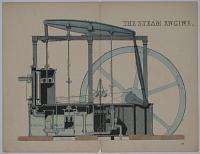
The Steam Engine. 29.
[Reynolds; n.d. c.1860.]
Coloured engraving. 215 x 280mm. 8½ x 11". Fold through centre of image, as normal.
A double-acting condensing rotative engine. The development of the steam engine in the 18th century was fundamental in paving the way for the Industrial Revolution. From Reynolds' 'Pictorial Atlas of Arts, Sciences, Manufacturers and Machinery'. Ex Collection: Norman Blackburn. In the Science and Society Picture Library.
[Ref: 20630] £65.00
(£78.00 incl.VAT)
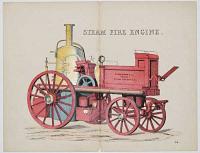
Steam Fire Engine. 34.
[Reynolds; n.d. c.1860.]
Hand-coloured engraving. 215 x 280mm. 8½ x 11". Fold through centre, as normal.
Horse-drawn fire engine patented by Shand, Mason & Co; a reputable fire engine production company. From Reynolds' 'Pictorial Atlas of Arts, Sciences, Manufacturers and Machinery'. Ex Collection: Norman Blackburn.
[Ref: 20636] £70.00
(£84.00 incl.VAT)
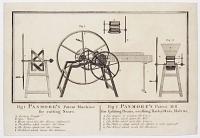
Fig 1 Pasmore's Patent Machine for cutting Straw. Fig 2 Pasmore's Patent Mill for splitting Beans, crushing Barley, Oats, Malt &c
[c.1810]
Engraving, sheet 150 x 215mm (6 x 8½").
Agricultural machinery designed by Thomas Pasmore of Doncaster to cut straw for cattle and crush grain. Probably published in an agricultural magazine.
[Ref: 43689] £95.00
(£114.00 incl.VAT)
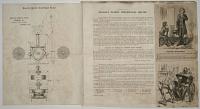
Stuart's Patent Centrifugal Beater.
Easton, Amos & Sons, Engineers, &c., Grove , Southwark, London. S.E.
[Anon] January 1st, 1859.
Broadside, promotional leaflet, lithographic diagram and explanatory letterpress including 'Directions for Working the Patent Pulp Engine'. Page 250 x 200mm, 9¾ x 8". Folded and glued to album page.
Trade advertisement for a specialised engine aimed at paper manufacturers and mill-owners. Provenance: from a scrap album compiled c.1840 - 1880 by Alfred Towgood of Riverside, a paper mill owner at St. Neots, Huntingdon. He was also a Lieutenant in the Duke of Manchester's Light Horse.
[Ref: 16539] £110.00
(£132.00 incl.VAT)

Optics. Plate XIII. 1 to 11 for Telescopes. 12 to 15 for Microscopes.
J. Pass sc.
Engraved for the Encyclopoedia Londonensis, 1820.
Coloured engraving. 270 x 215mm (10¾ x 8½"). Narrow margins. One small wormhole top left.
Diagrams of parts of optical instruments.
[Ref: 57127] £60.00
(£72.00 incl.VAT)
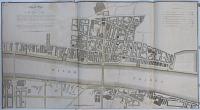
General Plan by Mess.rs Telford & Douglass For the Furth Improvement of the Port of London, shewing the Situation of the new Bridge in a line between the front of the Royal Exchange... To which is added, plans proposing a Deposite and Public Market for Coals on the Surry side of the River...
J.Barlow sculp.
[London, n.d., 1800.]
Coloured engraving on two sheets conjoined, totsl 640 x 1180mm, 23¼ x 46½". Trimmed to neatline, some chipping, small tears.
In 1799 a competition for designs to replace the 600-year-old London Bridge was held, for which the Scottish engineer Thomas Telford (1757-1834) submitted a plan for a cast-iron bridge with a single arch spanning 600 feet (180 m). This plan shows the positioning of the bridge and the associated developments proposed, including: a new "Exchange Street" running straight from the bridge to the Royal Exchange; embankments on either side of the River; and coal depôts on Bankside.
[Ref: 19713] £490.00
![[The Thames Tunnel: 5 illustrations from 'Memoranda and views relating to the tunnel now excavating under the Thames, from Rotherhithe to Wapping'.]](img-thumbnail/jpegs/32420.jpg)
[The Thames Tunnel: 5 illustrations from 'Memoranda and views relating to the tunnel now excavating under the Thames, from Rotherhithe to Wapping'.]
[1840.]
5 engraved illustrations, various sizes. Trimmed and laid on two album sheets.
Illustrations from a guidebook sold to the first visitors to the Thames Tunnel, being built by Marc Isambard Brunel (1769-1849). Work began in 1825 and finished in 1843, but the tunnel was opened to visitors in 1827, the year of the first edition of this guidebook. Brunel wrote much of the text, but draughtsmen and engineers working on the project provided the illustrations, including Pinchback, Richard Beamish and and Brunel's son, Isambard Kingdom Brunel. The illustrations include a map of the area, diagrams of Cochrane and Brunel's newly-invented tunnelling shield (including one with an overlay), longitudinal sections, a plan showing the progess of the digging (this example dated 1840) and a view of the tunnel with the figures of Brunel: Richard Beamish, William Gravatt and Isambard Kingdom Brunel.
[Ref: 32420] £230.00
(£276.00 incl.VAT)
view all images for this item
![[The Thames Tunnel: 5 illustrations from 'Memoranda and views relating to the tunnel now excavating under the Thames, from Rotherhithe to Wapping'.]](img-thumbnail/jpegs/49505.jpg)
[The Thames Tunnel: 5 illustrations from 'Memoranda and views relating to the tunnel now excavating under the Thames, from Rotherhithe to Wapping'.]
[1840.]
5 engraved illustrations, various sizes. Trimmed and laid on two album sheets.
Illustrations from a guidebook sold to the first visitors to the Thames Tunnel, being built by Marc Isambard Brunel (1769-1849). Work began in 1825 and finished in 1843, but the tunnel was opened to visitors in 1827, the year of the first edition of this guidebook. Brunel wrote much of the text, but draughtsmen and engineers working on the project provided the illustrations, including Pinchback, Richard Beamish and Brunel's son, Isambard Kingdom Brunel. The illustrations include a view of the tunnel with the figures of Brunel: Richard Beamish, William Gravatt and Isambard Kingdom Brunel, a diagram of Cochrane and Brunel's newly-invented tunnelling shield with an overlay, and a cross section of the Thames at Wapping with the shield.
[Ref: 49505] £230.00
(£276.00 incl.VAT)
![[A winch ferry.] No VIII.](img-thumbnail/jpegs/49764.jpg)
[A winch ferry.] No VIII.
H G Exc. [Leipzig: Henning Grosse, c.1614.]
Engraving. 130 x 145mm (5¼ x 5¾"), with large margins. Mounted on 17th century album paper at corners. Time stained.
An illustration of a winch ferry buoyed by barrels, one of the 152 plates in Heinrich Zeising's 'Theatri machinarum...', the first German book on machines.
[Ref: 49764] £140.00
(£168.00 incl.VAT)
![[A lifting crane.] No XXI.](img-thumbnail/jpegs/49766.jpg)
[A lifting crane.] No XXI.
H G Excud. [Leipzig: Henning Grosse, c.1614.]
Engraving. 125 x 145mm (5 x 5¾"), with very large margins. Time stained.
An illustration of a wooden crane, with lift gained by a screw thread turned by two men. One of the 152 plates in Heinrich Zeising's 'Theatri machinarum...', the first German book on machines.
[Ref: 49766] £130.00
(£156.00 incl.VAT)
![[Metal turning.] No 9.](img-thumbnail/jpegs/49767.jpg)
[Metal turning.] No 9.
H G Excud. [Leipzig: Henning Grosse, c.1614.]
Engraving. 125 x 145mm (5 x 5¾") very large margins.
An illustration of a man using a machine to shape metal tableware. One of the 152 plates in Heinrich Zeising's 'Theatri machinarum...', the first German book on machines.
[Ref: 49767] £140.00
(£168.00 incl.VAT)
![[Fire engines.] No 25.](img-thumbnail/jpegs/49770.jpg)
[Fire engines.] No 25.
[Leipzig: Henning Grosse, c.1614.]
Engraving. 125 x 145mm (5 x 5¾") very large margins.
An scene demonstrating the use of two types of fire engines. One of the 152 plates in Heinrich Zeising's 'Theatri machinarum...', the first German book on machines.
[Ref: 49770] £140.00
(£168.00 incl.VAT)
![[Fire engine.] No 22.](img-thumbnail/jpegs/49769.jpg)
[Fire engine.] No 22.
[Leipzig: Henning Grosse, c.1614.]
Engraving. 125 x 145mm (5 x 5¾") very large margins.
An illustration of water pump built on a trolley, designed to pump water from a river to fight fires. One of the 152 plates in Heinrich Zeising's 'Theatri machinarum...', the first German book on machines.
[Ref: 49769] £140.00
(£168.00 incl.VAT)
![[Fire engine boat.] No 23.](img-thumbnail/jpegs/49768.jpg)
[Fire engine boat.] No 23.
[Leipzig: Henning Grosse, c.1614.]
Engraving. 125 x 145mm (5 x 5¾") very large margins.
An illustration of water pump built on a catamaran, designed to pump water from a river to fight fires. One of the 152 plates in Heinrich Zeising's 'Theatri machinarum...', the first German book on machines.
[Ref: 49768] £140.00
(£168.00 incl.VAT)
![[A horse-drawn water pump.] No 4.](img-thumbnail/jpegs/49765.jpg)
[A horse-drawn water pump.] No 4.
[Leipzig: Henning Grosse, c.1614.]
Engraving. 125 x 145mm (5 x 5¾"), with large margins. Time stained.
An illustration of a water-pump (tympanum), with a wheel lifting the water driven by horse-powered gears. One of the 152 plates in Heinrich Zeising's 'Theatri machinarum...', the first German book on machines.
[Ref: 49765] £140.00
(£168.00 incl.VAT)

Indoor Frame For Thermometer In Kid and Silk Embroidery. Expressly Designed for the "Englishwoman's Domestic Magazine."
Ad. Goubaud. - Paris. Strasburgh, print G. Silbermann [n.d., c.1880].
Chromolithographic magazine illustration, sheet 285 x 190mm. 11¼ x 7½". Fold, as issued. Crease through lower right corner.
A design for an elaborate frame for a thermometer.
[Ref: 9516] £65.00
(£78.00 incl.VAT)
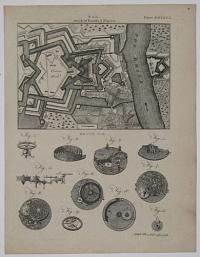
War. Attack of Fortified Places. Watch Work.
A.Bell Prin. Wal. sculptor fecit.
[n.d., c.1790.]
Engaving. 240 x 190mm, 9½ x 7½".
A page from an encyclopedia, illustrating the defences of a citadel on the Rhine, and the inner workings of a watch in eleven figures.
[Ref: 22324] £40.00
(£48.00 incl.VAT)

Plan and Elevation of the Waterloo Bridge over the River Thames.
Engraved by M. Dubourg 1 Buxton Place Lambeth.
1822 London Publish'd by J. Taylor at the Architectural Library, High Holborn.
Large folding aquatint plan, 300 x 675mm. 11¾ x 26½". Perspective view above, with plans and details and vignette view of the toll gate below. Two chips to upper margin, just into plate. Hole in title area.
George Dodd, a civil engineer who worked for John Rennie (1761 - 1821), proposed to build this bridge across the Thames from a point near Somerset House. Dodd left Rennie’s firm, and after the necessary funds had been raised by public subscription, the bridge was built to Rennie’s design between 1811 and 1817. The granite bridge had nine arches, each of 120 ft span, and was 2,456 ft long, including approaches. When it opened, the bridge was christened Waterloo Bridge, in honour of Wellington’s victory over Napoleon in 1815; before its opening it was known as 'Strand Bridge'. The bridge was replaced by the present Waterloo Bridge in 1945. See Guildhall Library Record: 29748 for plan dated 1816. See BL Maps K.Top.22.40.a. for a plan by Dubourg dated 1811.
[Ref: 23279] £360.00

A Perspective View of the Engine, now made use of for Driving the Piles of the New Bridge at Westminster: most Humbly Inscrib'd to the Hon.ble Commissioners for Building the said Bridge, by the Inventor- James Vaulone, Watch-Maker
H. Gravelot delin. W.H. Toms sculp [in image]
Printed for Carington Bowles in St Pauls Church Yard. London.
Engraving, sheet 445 x 350mm (17½ x 13¾"). Trimmed inside platemark; glued to backing sheet and folded. Scarce.
Pile driver for building over water, consisting of a floating platform on which horses turn a wheel which drives the pilse downwards. Later 18th century reissue by Carington Bowles, of a plate first published by its engraver, W.H. Toms, in 1748. At that time the construction on the first Westminster Bridge had been underway for nine years (and would not be completed for another two). It was probably published to capitalise on public interest in the project. For a related print demonstrating technology used to construct Westminster Bridge see ref.2555.
[Ref: 37646] £320.00

Perspective view of the ENGINE made use of for Sawing off under Water, The Piiles which help'd to support the Centers, for turning the Arches of WESTMINSTER BRIDGE. most humbly inscrib'd to the Right Honble. & c. The Commissioners for building the said Bridge by the Inventor. {Willm. Etheridge, Carpenter} [contemporary ink mss]. A Perspective View of the Engine, as it appears in the Water, with the Floats, and Men at Work. A Perspective View of the Engine, as it appears out of the water to an eye 13 Inch.es:Distant from this Mark ... Explanation...
Cars. Labelye Delint. P. Foudrinier Sculpt.
Publish'd {May 1st}[contemporary ink mss] 1745.
Engraving. 350 x 465mm. Creases with stained edges
Charles Labelye, a naturalised Swiss engineer and architect. was appointed in May 1738 to the Westminster Bridge Project. The initial design was for a timber superstructure with stone piers and abutments. This was abandoned after damage to the works caused by the severe winter of 1739-40, during which the Thames froze solid. All 140 wooden piles were destroyed. So Labelye produced a design for a Portland stone bridge with 13 large semicircular arches and two small, and work recommenced. This engraving appears to have been the property of 'Willm. Etheridge, Carpenter', who is regarded as the inventor of the machine drawn here by Labelye. William Etheridge (1709-1776) was one of a very long family line of carpenters called variously Edrich, Edriche, Eteridge, or Etheridge from Stradbroke and Fressingfield in Suffolk. His career as a master carpenter first comes to light in 1738-1749 when he worked under James King in the building of the first bridge to cross the Thames at Westminster, first as King's foreman, then replacing him after King's death in 1744. He was credited as the inventor of a battering ram to assist in the striking of the centres, as well as the underwater saw to cut off piles underwater. From 1747-1750 he worked on the Walton Bridge, and in 1748 produced the design and model for the Queens' bridge, Cambridge. Ex. Blackburn Collection.
[Ref: 2555] £520.00
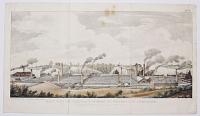
East View of the Salt Works at Wharton in Cheshire. As erected by Mr. Furnival, from 1828 to 1832.
Jobbins & Cheffins litho: Southampton Buildings, Holborn.
Lithograph with hand-colouring, sheet 185 x 320mm (7¼ x 12½"). Tears to edges. Creases as normal
The salt works at Wharton (now Winsford) in Cheshire. Rock salt arrived in the area in the Triassic period, and was excavated from the seventeenth century onward. Winsford Rock Salt Mine opened in 1844 and is still in operation.
[Ref: 43690] £160.00
(£192.00 incl.VAT)

![The Parisian Portable Alarum [Alarm],](img-thumbnail/jpegs/16457.jpg)
![[Trade flyer] Improved Drain Tile Machine. (Etheredge's Patent.)](img-thumbnail/jpegs/18213.jpg)

![[Straw-burning ploughing engine.]](img-thumbnail/jpegs/20902.jpg)



![[Set of Six.] The descent into the salt-mines of Dürnberg.](img-thumbnail/jpegs/44626.jpg)
![View of the Patent Sa[l]t works & Rock Salt Mine,](img-thumbnail/jpegs/57089.jpg)










![[The Thames Tunnel: 5 illustrations from 'Memoranda and views relating to the tunnel now excavating under the Thames, from Rotherhithe to Wapping'.]](img-thumbnail/jpegs/32420.jpg)
![[The Thames Tunnel: 5 illustrations from 'Memoranda and views relating to the tunnel now excavating under the Thames, from Rotherhithe to Wapping'.]](img-thumbnail/jpegs/49505.jpg)
![[A winch ferry.] No VIII.](img-thumbnail/jpegs/49764.jpg)
![[A lifting crane.] No XXI.](img-thumbnail/jpegs/49766.jpg)
![[Metal turning.] No 9.](img-thumbnail/jpegs/49767.jpg)
![[Fire engines.] No 25.](img-thumbnail/jpegs/49770.jpg)
![[Fire engine.] No 22.](img-thumbnail/jpegs/49769.jpg)
![[Fire engine boat.] No 23.](img-thumbnail/jpegs/49768.jpg)
![[A horse-drawn water pump.] No 4.](img-thumbnail/jpegs/49765.jpg)





